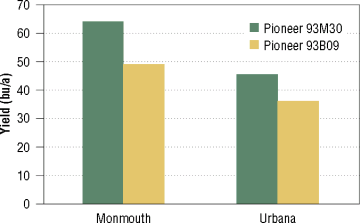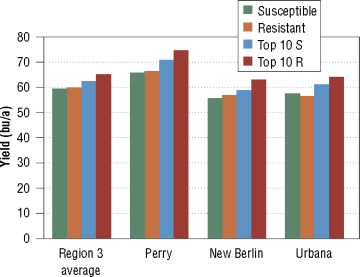Misconceptions about SCN Management in Illinois
 |
Terry NiblackProfessor and Extension Specialist in Nematology
|
The soybean cyst nematode (SCN) remains the most damaging soybean pathogen in Illinois. Conservative estimates of the crop, its value, and the percentage use of resistant varieties place the value of losses caused by SCN alone in 2005 at $167 million. Consideration of some of the research data included in this paper would place the estimate at closer to $250 million.
It's time to look at the most common misconceptions about SCN management to understand why these losses are not declining over time. Based on what we in the Nematology Lab hear from growers, perhaps the most common misconception about SCN management is that it is unnecessary, and secondly that it is too complicated.
Why SCN Management is Necessary: It's Everywhere, But Can't Be Seen

Figure 1 – Average population densities of SCN in Illinois according to region.
In 2004 and 2005, we conducted a survey of SCN distribution and population densities to verify that our estimate of the number of infested soybean fields was accurate. Samples were collected throughout Illinois from soybean fields near randomly selected GPS coordinates along transects. At the time this paper was written, 219 of the samples had been processed for SCN egg counts. As expected, we observed that 83.5% of the soybean fields were infested with SCN, an increase from the results of the Illinois survey conducted by Iowa State University in 1999. However, the large egg counts we observed were somewhat unexpected (Figure 1). Southwestern Illinois, the area of the state first infested with SCN, continues to have the highest average populations.
Yield loss in SCN-susceptible varieties is dependent on environmental factors, but also is highly correlated with the SCN egg count at planting. Losses can be measured when the SCN egg count exceeds 500 per 100 cm3 soil, and we recommend that SCN-resistant varieties be planted in fields with egg counts of 500 or more. In most fields with egg counts between 500 and 3,000, yield loss occurs without any visible evidence of damage caused by SCN. Symptoms (stunting and chlorosis) are observed in fields with counts above 3,000. At densities greater than 10,000 eggs, resistant varieties can be damaged, and we recommend planting a nonhost such as corn. Because field characteristics vary, our recommendations do not apply to every situation; however, they are reliable averages for most parts of Illinois.
In our survey, 16% of the samples had egg numbers between 3,000 and 10,000 per 100 cm3 soil, and 4% had egg numbers exceeding 10,000, ranging up to 42,800 100 cm3 soil. Very few fields showed recognizable symptoms of SCN damage, although we saw plenty of soybean aphids, beetle injury, charcoal rot, sudden death syndrome, and other yield-reducing agents. None of these occurrences was correlated with changes in SCN egg counts.
Why SCN Management is Necessary: It's Still Causing Big Losses
One indisputable fact about SCN is that it causes soybean yield loss. The losses vary, as mentioned in the previous paragraph. However, if you compare good SCNresistant varieties with good SCN-susceptible varieties in replicated plots in infested fields, the SCN-resistant variety will yield more (Figure 2).
In 2005, losses due to SCN were somewhat greater than average in areas strongly affected by drought, but were about average across the state. Losses can be demonstrated even in fields with low to moderate SCN egg counts (Figure 3).

Figure 2 – Yield of SCN-resistant (Pioneer 93M30) and susceptible (Pioneer 93B09) soybean varieties in SCN-infested experimental plots in 2005. Egg counts per 100 cm3 soil at planting were 3,224 at Monmouth and 4,747 at Urbana.

Figure 3 – Yields of SCN-resistant and SCN-susceptible soybean varieties in the Soybean Variety Trials, Region 3, in 2005. SCN egg counts were low in Perry and Urbana, and moderate in New Berlin.
Why SCN Management is Necessary: It's Not Just About Yields (Gasp!)
SCN management strategies should have two goals: first, to maximize soybean yield; and second, to reduce the SCN egg count. Achieving the first goal will maximize profits in a given year; achieving the second goal will help maximize profits in future years. Small SCN populations are much easier to manage than trying to reduce SCN populations that get too large. Large population densities increase the risk that adaptation to resistance will occur (read the following section).
Many soybean producers labor under the misconception that if they know SCN is present and they plant a SCN-resistant variety, they have taken care of the problem. This may be true for a few years after an infestation is discovered. But it is absolutely essential that SCN egg counts be monitored over time—perhaps only once every 4 to 6 years—to be sure that the SCN management strategy is working, that is, egg counts remain stable or decline. An increasing egg count may be a signal that the SCN population has adapted to resistance.
Uncomplicated SCN Management: Measuring Adaptation to Resistance
| SCN Type* | Number of samples | Percentage | |||
|---|---|---|---|---|---|
| 0 1 2 4 |
17 12 81 0 |
15 11 74 0 |
|||
| Total | 110 | 100 | |||
Adaptation to resistance—what we used to call "race shift"—is something that happens very readily in SCN populations. For example, in 1991, a survey was conducted in Illinois to determine whether there were populations that were able to break resistance. The results showed that 64% of the SCN populations were unable to attack any resistant varieties. These populations were classified as "race 3," what we would call IL SCN Type 0 today. The remaining populations were classified as races 1, 2, 4, and 5, what we would call IL SCN Type 2 today. In addition, compared with the SCN populations we observe now, we would call most of them "weak," meaning that they could attack resistant varieties, but only at a low level. Only one population was "strong" enough to damage resistant soybean.
The situation has changed considerably over the past 15 years. A preliminary survey we conducted in southern Illinois in 2004 revealed that 82% of the SCN populations could attack most resistant varieties. IL SCN Type tests we have conducted for farmers showed that 85% of the SCN populations could attack most resistant varieties (Table 1). At the time this paper was written, we were still conducting IL SCN Type tests on samples collected during our 2005 survey. Early indications are that the results will be similar to these estimates.
Uncomplicated SCN Management: Rotate—Rotate—Rotate
SCN management isn't complicated. Growers should test fields periodically for SCN egg counts, then customize a SCN management strategy based on three simple guidelines:
- Rotate with a nonhost (such as corn).
- Rotate with resistant varieties. Choose the highest yielding varieties with the highest levels of resistance by checking out the Variety Information Program for Soybean at http://www.vipsoybeans.org/.
- Rotate resistance. Don't grow the same resistant variety twice in a row, even with corn grown during years between growing resistant varieties.